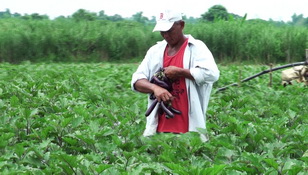
ISAAA Blog: Hope for the Harvest
August 10, 2016| |
 At the earliest light of day, farmers march to their fields with the hope of a good harvest. They till their land, plant seeds, and perform farming practices that they deem helpful to grow good crops and get high yields. A Filipino folk song best describes the life of a farmer in the field: Magtanim ay ‘di biro (Farming is not a joke).
At the earliest light of day, farmers march to their fields with the hope of a good harvest. They till their land, plant seeds, and perform farming practices that they deem helpful to grow good crops and get high yields. A Filipino folk song best describes the life of a farmer in the field: Magtanim ay ‘di biro (Farming is not a joke).
On the other side of the field, scientists are growing crops not for the yield but to harvest information about the biotech crops they are studying. They carefully follow research guidelines alongside with the protocols implemented by the government with the hope that after all the backbreaking work; the crops they develop will eventually crossover to the farmers' fields.
In the Philippines, genetically modified (GM) maize resistant to a major insect pest and specific herbicides continues to be one of maize farmers' best options. After over a decade of commercializing biotech corn, the Philippines has finally achieved self-sufficiency. This has helped the country to save Php60M from corn imports from 2010-2013.
Eggplant, the top vegetable in the country, has been developed by the University of the Philippines to be resistant to its major insect pest – the fruit and shoot borer. The research started in 2003 following the strict rules implemented by regulatory government agencies. Alongside the conduct of the study, scientists and science communicators were equipping the public with facts about the biotech crop, which could potentially be the first GM food crop in the country. These efforts continued until the last leg of the research, which ended with a bang — biotech critics from Greenpeace filed a Writ of Kalikasan against the biotech crop in 2012.
Continue reading in the ISAAA blog site.
| |
Biotech Updates is a weekly newsletter of ISAAA, a not-for-profit organization. It is distributed for free to over 22,000 subscribers worldwide to inform them about the key developments in biosciences, especially in biotechnology. Your support will help us in our mission to feed the world with knowledge. You can help by donating as little as $10.
-
See more articles:
-
News from Around the World
- FAO, WFP Hail Global Food Security Act
- Undergraduates Discover Mechanism Tied to Plant Height
- Chinese Regulators Visit U.S. to Study its Regulatory System
- Lift Bans on GM Crops, Says Australia's Productivity Commission
- Australian OGTR Calls for Comments on Application for Commercial Release of GM Cotton
- Study Shows Acceptability of GM Foods among Pakistani Consumers
- Researchers Uncover 'Switch' that Triggers Plant Flowering
-
Research Highlights
- Reduction of GIGANTEA Expression Enhances Salt Tolerance in Polish Canola and Arabidopsis
- TaZFP34 Gene Enhances Root-to-Shoot Ratio in Wheat
-
Beyond Crop Biotech
- Plant Sugars Influence Malaria Transmission
- GE Mosquitoes to Control Diseases in Cayman Islands and Florida
-
From the BICs
- Vietnam Holds Conference on Biological Research and Teaching
-
Announcements
- CSS 2016 and SEED Expo
-
Resources
- ISAAA Blog: Hope for the Harvest
-
Plant
- SMARTER Cereal Breeding Using Small RNAs
-
Read the latest: - Biotech Updates (December 17, 2025)
- Gene Editing Supplement (December 17, 2025)
- Gene Drive Supplement (February 22, 2023)
-
Subscribe to BU: - Share
- Tweet
